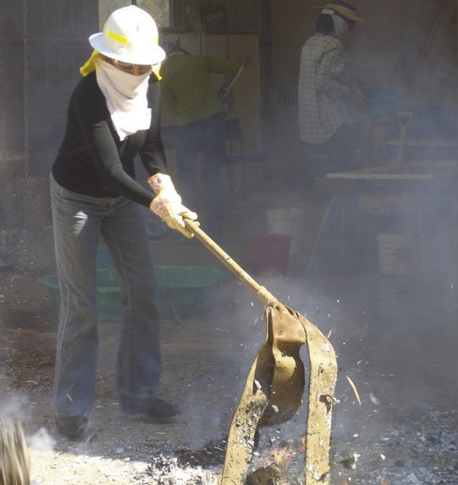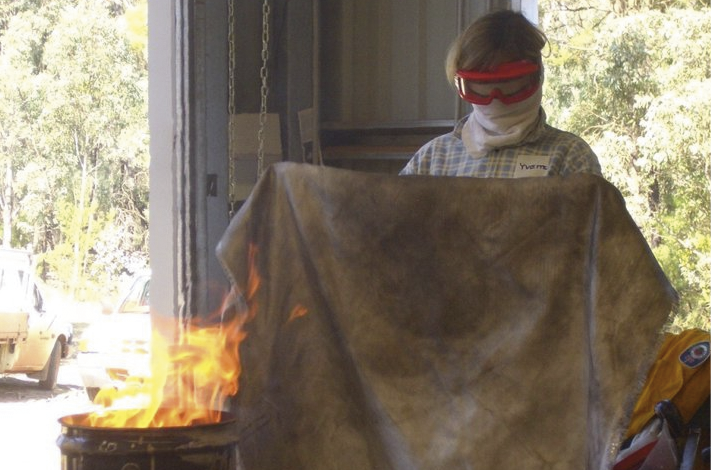Practical stories: Genesis of women's programs
NSW Rural Fire Service
NSW Rural Fire Service Community Engagement is involved in fire safety programs teaching women a range of survival techniques.
Article
There has been a slow growth of bushfire safety programs for women in NSW following positive feedback from other brigades that have ventured into delivering specific programs for women.
Women’s fire awareness
The NSW RFS Canyonleigh Brigade targets women who are at home alone or with children while husbands or partners work out of the area. This group is one of the higher-risk groups in the community during times of emergency.
The program was developed in 2002 for the wives of NSW RFS brigade members. A community educator for the brigade decided that wives and partners of brigade members should be self-sufficient and ready to defend their property and family in an emergency. When the program started the training involved putting out spot fires, wearing the correct protective clothing, water pump practise, and property visits to discuss protection around the home.
It was a couple of years later that the same brigade member recognised that trying to change men’s behaviour was significantly harder than trying to change women’s. So he asked his wife, who had joined the brigade to learn basic fire management skills, to develop a women’s program as he believed the program should be taught by a woman. In 2009, she ran a refreshed women’s program and, although she was the only female brigade member present, the women did not seem bothered. Men were needed for the practical activities, and the brigade community educator co-facilitated providing the deeper knowledge of fire behaviour.
The current program is very similar, with one essential difference being that the training is facilitated by women from within the brigade. Two female facilitators now run the training with male brigade members assisting. One of the women has practical bushfirefighting experience while the other has adult education experience.
Program components
The delivery style varies across the NSW. Some programs are run at a brigade shed or other community centre, with practical fire exercises run outside the venue. Others are run on private property, or a combination of the two by starting in a brigade shed before travelling to a private property to carry out practical exercises.

Image: NSW Rural Fire
Participants experience a fire situation using basic tools to better understand how to cope and prepare for a real situation.
A variety of methods are used to engage participants. Some use testimonials of previous program participants, videos of women affected by bushfires, or case studies of fires. A primary goal of many programs is that women feel comfortable right from the start, with casual activities at the beginning. This could include placing a marker on their property, which often leads to neighbours meeting each other for the first time, or getting participants to share ideas on different themes on paper pinned up around the room.
The Canyonleigh program includes a component on emotional preparedness which is sometimes missing from other programs. The program uses various methods to communicate the need for emotional preparedness. One simple and effective activity is an exercise where participants dress in their appropriate firefighting clothes and try to carry out activities that form part of their Bushfire Survival Plan – all in extreme heat and darkness (thanks to heaters and block-out blinds). Other distractions are added like loud noises and the sound of an approaching bushfire.
A common element in NSW programs is the teaching of practical skills including using a water pump and putting out spot fires. Training builds on this by getting participants to attempt to put out spot fires with no forewarning and only basic tools. These tools are common household items such as mops, buckets, shovels, toy water pistols, blankets and even small spray bottles and backpack style sprayers. Participants can discuss how they felt being confronted with the spot fire and how hard it was to deal with it. Participants then pair up and try again. The group develops a better understanding of what is involved and what is effective in putting out spot fires.
The majority of the NSW programs explain the purpose and benefits of a Bushfire Survival Plan. Some training sessions take it further by ensuring each participant takes home a completed (or as near as possible) plan. Other topics that may appear in individual courses include map reading, preparing pets, and vehicle safety.
Several courses follow-up with participants to go over their Bushfire Survival Plan and provide advice about individual property preparation. The follow-up visit helps build local relationships and provides support to participants.

Image: NSW Rural Fire
Participants experience a fire situation using basic tools to better understand how to cope and prepare for a real situation.
Results
Residents have said they feel more comfortable approaching their local brigade members for help, making decisions about what to do when a bushfire is in the area, and feel more confident in defending their home. Many realise that they aren’t capable of defending their home and make a clear commitment to leave early.
The Canyonleigh Brigade note that:
“As well as an increase in awareness we have noticed an increase in action. For example, on 8th January 2013 we had a Catastrophic Fire Danger Rating. Women who had done a recent program talked with one another, gave each other support and told each other what they were doing. These women left the area, moved horses – basically followed their Bushfire Survival Plan – with their husbands and children in tow.”
The NSW RFS are developing a consolidated course for women, with input from the South Australia Country Fire Service and their Firey Women program that aims to give participants:
- an improved awareness and understanding of their bush fire risk
- a completed Bushfire Survival Plan
- an understanding of the level of psychological preparedness necessary to defend their home
- skills to successfully put out spot fires using several different methods, and
- an increased likelihood to survive a bushfire and the knowledge to better protect their family.
Further information
NSW Rural Fire Service Community Engagement
Email: community.engagement@rfs.nsw.gov.au.


